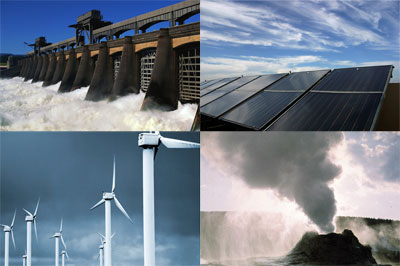California's installed renewable energy numbers may surprise you

If asked what type of renewable energy is most prevalent in California, most would choose solar or wind, but in reality, those two forms of renewable energy aren't even close. Instead, the current California champion for renewable energy is geothermal, followed by small hydro. Say what?
As an example, on Wednesday May 4, 2011, geothermal energy production in California was 23,980 MWh, followed by small hydro with 13,210, then wind at 10,166. Solar power was last, with 3,094, behind biomass and biogas. Yes, that's right, solar power produces the least amount of renewable energy, even as it (and wind) get most of the attention. Total renewables production for the day was 61,549 MWh against a total system demand of 670,435 MWh or about 9%. Clearly, California has a long way to go to meet its ambitious goal of 33% renewable energy by 2020.
These numbers are from California ISO, a non-profit that monitors and operates much of California's high-voltage wholesale power grid. They post full details of renewable energy production each day at Renewables Watch and real time system demand overall at Today's Outlook.
Geothermal energy, for those who may not know, uses hot liquids from within the earth to power turbines. California has enormous amounts of undeveloped geothermal in addition to its substantial installed base. Geothermal is steady, produces power 24/7 and doesn't care if the sun is out or the wind is blowing. Small hydro is also quite steady, certainly much more than solar or wind. For reasons known only to their analysts, the powers-that-be in renewable energy in California have decreed that while small hydro is renewable energy, large hydro is not. This is nonsensical. Perhaps someone doesn't want Bechtel building more dams, as there appears to be no other reason for this decision.
California is the leader among states for renewable energy, yet as Cal ISO shows, it gets a decidedly small amount of its power from renewables. Even worse, a considerable amount of California power is what Cal ISO delicately calls "imports," which is power imported from other states. This power is often not renewable at all and frequently comes from coal plants on Indian land in Arizona and Nevada. Here's the dirty little truth. Coal plants are banned in California, so California imports coal power from hundreds of miles away, all the while putting up a fine show of being green and focused on renewable energy. The City of Los Angeles is notorious here, as it gets substantial power from such coal plants.
A big coal plant can produce 1-3 GW (1 GW = 1,000 MW) while a nuclear plant can output 3-5 GW. There are no individual renewable energy plants that can come near these numbers. Hopefully one day there will be. For this to become a reality, the transmission grid will need to be remade to handle large amounts of variable power production coming from all directions. Also, renewable energy plants will need to be able to store power for later use. Then California might be able to reach that 33% renewables goals by 2020.



